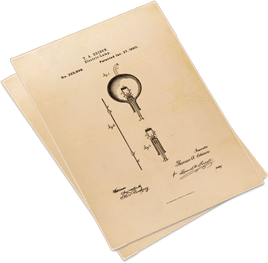“Why shouldn’t I just get a patent on my secret knowledge and have the explicit grant of the government protecting my exclusive use of it?”
That is an excellent question that goes to the heart of your decision about how to best protect certain of your innovations. After all, in many cases a patent is a trade secret made public in exchange for a promise of exclusivity in its use for a time. Patent protection is potent protection where it is appropriate, practical, and possible to obtain, but it is not omnipotent protection.
Patent protection is usually possible to obtain for all inventions — including not only novel devices, but also novel processes and methods. It is always appropriate for those inventions that will become obvious to the interested public when the invention is put into practice. That is, a patent may be the only way to protect something that simply can’t be kept secret once you put it to use in order to benefit from it.
However, when your secret knowledge can be used in secret, then the option of maintaining it as a trade secret may be worth considering. To begin with, some very valuable “inventions” are not patentable by definition: certain processes or methods that are largely abstract may be classified as unpatentable “algorithms”; certain “recipes” combining elements that are all separately well-know may be deemed “obvious” or “anticipated” (as defined under patent law) and unpatentable; and information, particularly negative information, is usually not patentable. Other innovations that are of limited or only occasional value may not be cost-effective to patent, considering not only the initial cost, but also the continuing cost of maintaining a patent. Still other discoveries may be so narrow or specialized in their scope or application that it may be impractical to try to obtain patent protection of them. So that any new thing or process that may not be patentable, that may not be worth the expense of obtaining a patent, or even that has been denied patent protection, may still be maintained as a trade secret. (In the U.S., unless you decide to seek patent protection in other countries, you can elect to keep the patent application confidential until a patent issues from it.)
The most difficult choice between patent protection and keeping a trade secret arises when you have developed a clearly patentable device or process of significant value, and it is one that you could use in such a way that neither the general public nor especially your competitors could deduce your secret. Then trade secret protection in lieu of patent protection may be worth some consideration. After all, the purpose of governments granting patent protection is to encourage inventive persons to make new technologies known to the whole world. By obtaining a patent, you gain the right to exclude others from making, selling, or using your device or process, but for a limited period of time (currently fewer that 20 years in practical terms), after which anyone can make or use it. A trade secret, on the other hand, remains yours, exclusively, for as long as you are able to maintain its secrecy. (Perhaps for centuries, as in the case of the Zildjian family secret noted elsewhere in this section.) Furthermore, the subject of a published patent may be improved upon by others, and the improvement patented by them, thereby excluding you from employing the improvement of your own invention without license.
Finally, patent protection is national. By obtaining a patent, you gain strong protection of your exclusive right to make, sell, and use your device or process, but only in the country or countries that have granted you patent protection. Trade secret protection is universal for as long as you are able to keep the secret.


